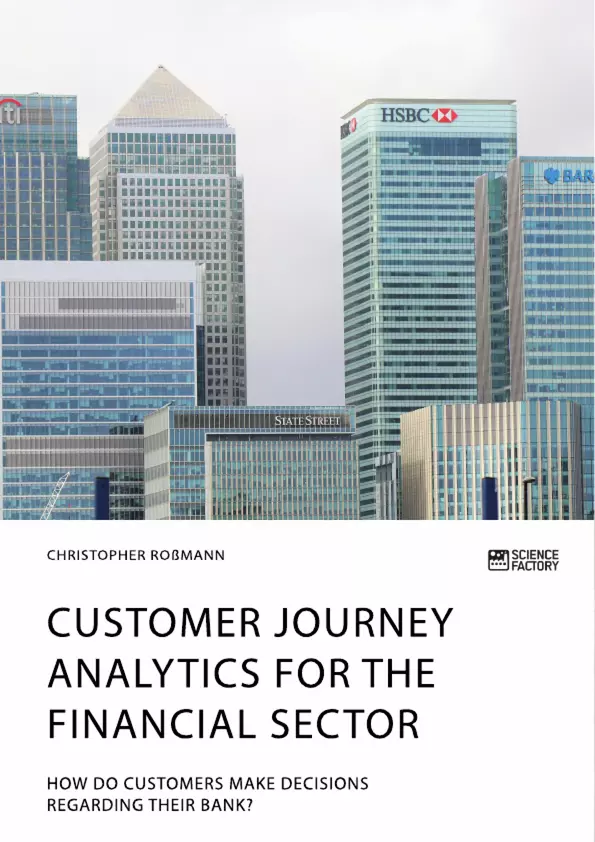The financial industry is facing wide-ranging changes due to historically low interest rates, higher regulation and the rise of online banks and digitization. Traditional retail banks have been losing market share, bank branches have been merged as well as products and services changed.
Christopher Roßmann shows how important it is that banks understand their customers’ decision-making process. Therefore, he conducts a customer journey analysis for the German saving bank. He focusses on comprehensive bank consultations.
Roßmann uncovers reasons for a low perception of the consultation approach by customers. In his book, he provides improvement proposals for several units of the bank and develops an improved target vision for the customer journey.
In this book:
- Sparkasse;
- Sparkassen-Finanzkonzept;
- process management;
- product management;
- marketing;
- UX
Table of Contents
- Abstract
- Table of Contents
- 1 Introduction
- 1.1 Professional Background and Motivation
- 1.2 Purpose and Research Questions
- 1.3 Outline of the Thesis
- 2 Customer Journey Analytics (CJA)
- 2.1 Introduction and Definition
- 2.2 Customer Journey Mapping (CJM)
- 2.3 Touchpoints
- 3 Customer Journey Analytics in the Financial Industry
- 3.1 The Financial Industry in the Current Environment
- 3.2 Channel Strategy
- 3.3 Implementing a CJA Project at a Financial services provider
- 3.4 Hypothetical Customer Journey
- 4 Empirical Research: Research Methodology
- 4.1 Gathering Data for CJA
- 4.2 Critical Reflection of Gathering Data through Interviews
- 4.3 Empirical Research: Data Collection
- 5 Results
- 5.1 Expert Interviews
- 5.2 Customer Journey Maps
- 5.3 Discussion and Evaluation
- 6 Concluding Recommendations
- 6.1 Mapping the Journey in the Target Vision
- 6.2 The Customer Journey Map in the Target Vision
- 7 Conclusion and Critical Reflection
Objectives and Key Themes
This study aims to examine the customer experience in the German savings bank industry, focusing on the comprehensive bank consultation approach. The study explores the decision-making process of customers regarding banks and their financial products and services, investigating the customer journey and identifying reasons for low perception of the consultation approach. The study provides improvement proposals and develops an improved target vision for the customer journey.
- Customer journey analytics in the financial sector
- Decision-making process of customers regarding banks and financial products
- Customer experience with comprehensive bank consultations
- Improving customer perception of consultation approaches
- Development of a target vision for the customer journey
Chapter Summaries
The first chapter introduces the research topic, outlining the professional background and motivation, stating the purpose and research questions, and providing an outline of the thesis. The second chapter introduces customer journey analytics (CJA), defining the concept, explaining customer journey mapping (CJM), and highlighting touchpoints in the journey. The third chapter focuses on CJA in the financial industry, examining the industry's current environment, channel strategy, implementation of CJA projects, and outlining a hypothetical customer journey.
Chapter four delves into the empirical research methodology, discussing data gathering for CJA, critically reflecting on the method of gathering data through interviews, and presenting the data collection process. The fifth chapter presents the results of the study, covering expert interviews, customer journey maps, and discussions and evaluation. Finally, the sixth chapter presents concluding recommendations, including mapping the journey in the target vision and outlining the customer journey map within the target vision.
Keywords
The study focuses on customer journey analytics, comprehensive bank consultations, customer experience, financial industry, decision-making process, German savings banks, customer perception, and target vision for the customer journey. The research utilizes empirical data gathered through interviews to provide insights and recommendations for improving customer experience and enhancing the overall customer journey.
- Arbeit zitieren
- Christopher Roßmann (Autor:in), 2019, Customer journey analytics for the financial sector. How do customers make decisions regarding their bank?, München, GRIN Verlag, https://www.grin.com/document/468695



